After over three centuries of Dutch colonisation, Indonesia declared independence on August 17, 1945, shortly after Japan surrendered to the United States. New Delhi: Indonesia Independence Day, known as ‘Hari Kemerdekaan’, is celebrated annually on August 17 to mark the country’s declaration of Independence from the Netherlands in 1945. The day, also called ‘Tujuhbelasan’ or ‘the Seventeenth’ locally, was officially designated a national holiday by government decree in 1946.
Despite the initial declaration, Indonesia faced four more years of struggle before gaining official recognition of its Independence. On Indonesia Independence Day, let us look at how it got Independence and some quick facts about the Asian nation and its relation with India. According to the 2020 Indonesian Census, Jakarta, the capital of Indonesia, had a population of 31.

24 million. This makes it the most populous region in Indonesia and the second-most populous urban area in the world after Tokyo (Photo credit: Fadil Aziz/The Image Bank/Getty Images) How did Indonesia get Independence? The road to Indonesia’s Independence was long and complex, with the country suffering invasions and takeovers over hundreds of years. The archipelago was once made up of small kingdoms, with powerful kingdoms like Srivijaya and Sailendra.
The Majapahit Empire ruled over much of present-day Indonesia, followed by the Mataram Sultanate. The Dutch arrived in the 17th century and ruled for 350 years, exploiting the local population. Japan invaded during World War II, and Indonesia declared Independence in 1945.
After years of war, the Dutch finally acknowledged Indonesia’s Independence in 1949. Diamond Beach is one of the most beautiful in Bali (Photo credit: Nora Carol Photography/Moment/Getty Images) India-Indonesia Relation In 2024, India and Indonesia celebrated 75 years since establishing diplomatic relations. India and Indonesia have a strong history of collaboration and shared commitment to democracy, pluralism, and diversity.
Since 1991, bilateral relations have rapidly developed in political, security, defence, commercial, and cultural fields. The strategic partnership was established in 2005, and Indonesia is India’s second-largest trading partner in ASEAN. Both nations have worked on increasing bilateral trade, promoting foreign investment, and strengthening diplomatic relations with all ASEAN members.
There is considerable potential for expanding trade in various sectors and enhancing bilateral cooperation in infrastructure development and energy. Both countries have active cultural exchanges and should encourage private sectors to invest in infrastructure and manufacturing. Defence ties should be enhanced through technical capacity building and contributing to developing Indonesian capacities.
India and Indonesia are natural partners in ensuring the development and security of the Indian Ocean and the Pacific coastal region. They can collaborate to address non-traditional threats such as piracy, smuggling, and transnational crimes. Pura Ulun Danu Bratan.
Hindu temple on Bratan lake landscape. One of the famous tourist attractions in Bali. Indonesia (Photo credit: Fertnig/E+/Getty Images) Quick Facts about Indonesia Indonesia, an immense and captivating nation, proudly holds several remarkable distinctions that showcase its natural beauty and cultural richness.
The world’s largest archipelago comprises a stunning collection of over 17,000 islands, each offering a diverse tapestry of landscapes and communities. Indonesia’s claim to the third-highest number of volcanoes globally speaks to its land’s raw, untamed power. Its volcanic landscapes are awe-inspiring and integral to the nation’s geography and history.
Indonesia’s natural wonders extend to its flora, including the breathtaking Rafflesia arnoldii, recognised as the largest flower in the world. Moreover, the grandeur of Borobudur Temple, the largest Buddhist temple globally, leaves visitors spellbound. This architectural marvel, located in Central Java, covers an expansive 162,400 square feet and features over 2,670 bas-relief panels that narrate captivating stories of ancient times.
Another extraordinary facet of Indonesia is its status as the sole habitat of the awe-inspiring Komodo dragon, the largest living lizard known to humanity. Observing these majestic creatures in their natural habitat is an experience unlike any other. Indonesia’s heritage is further enriched by its eight UNESCO World Heritage Sites, such as Komodo National Park, Lorentz National Park, Tropical Rainforest Heritage of Sumatra, and Ujung Kulon National Park, offering a glimpse into the country’s staggering biodiversity and natural splendour.
Cultural diversity thrives in Indonesia, a land home to over 600 ethnic groups and subgroups, each contributing to the tapestry of traditions that make the nation so vibrant. Notably, the Javanese people, constituting 40 per cent of the population, have a rich and storied cultural heritage that adds to Indonesia’s diverse mosaic. Another fascinating dimension of Indonesia is the island of Bali, which is predominantly Hindu due to historical influences from traders and the Majapahit Empire.
These influences brought Hindu and Buddhist practices to the island, shaping its distinctive cultural and religious landscape. Indonesia’s coastline, the second largest in the world, spans over 54,000 kilometres, offering a mesmerising and varied array of coastal beauty and marine ecosystems..



















